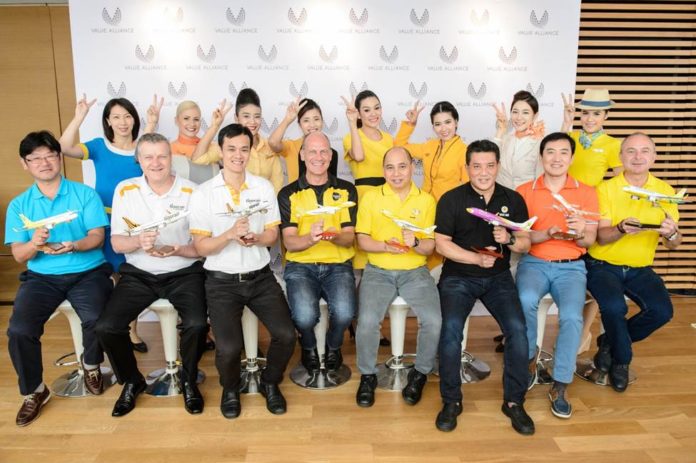
CEOs and stewardesses of Value Alliance members
Four of the eight LCC members of Value Alliance are now interlined, enabling passengers to view, select and book flights, as well as pick ancillaries such as meals, extra luggage and seats, in a single transaction.
The four are Scoot, NokAir, NokScoot and Vanilla Air. The other four – Cebu Pacific, Jeju Air, Tigerair Singapore and Tigerair Australia – will be interconnected by the first quarter, according to Mildred Cheong, general manager, ABB Asia-Pacific, a technology provider for the multi-carrier interlining and booking system.
This progress is key to the success of the fledgling alliance initiatives led by LCCs in Asia-Pacific. Unlike legacy carriers where an airline seat is all-inclusive, LCCs’ inherent model of unbundling seats, meals, extra luggage, travel insurance and other ancillaries have made it a complex task to interline them.
U-Fly Alliance became the world’s first LCC alliance when it debuted in January last year with five members, Seoul’s Eastar Jet, HK Express, Yunnan’s Lucky Air, Urumqi Air and Chongqing’s West Air, followed by Value Alliance a few months later in May.
A chief reason for these groupings is the need for the airlines to grow without losing their independence, said Steven Greenway, deputy CEO of U-Fly Alliance, who spoke at the two-day Aviation Festival Asia in Singapore which ended yesterday.
Any LCC with below 100 aircraft and are confined to a certain country are classified as ‘suboptimal’ in size, he said, citing Cebu Pacific as an example of being predominantly a Philippine domestic carrier with some international service.
“But Cebu Pacific is not going to break out and set up shop in Europe, Australia or Hong Kong. And while 10 years ago you had LCCs setting up subsidiaries in certain countries, for example Jetstar Asia in Singapore or Thai AirAsia, all of that is slowing down now, in some cases, going into the reverse,” said Greenway.
“Jetstar Hong Kong got rejected by local authorities who claimed that it was run out of Melbourne, which is true to a certain extent, while AirAsia had a close call in India (over whether it’s an Indian-controlled airline). You see all these barriers coming out.
“So if you’re suboptimal and are stuck in a geographic fix, what do you do? There is only so much domestic market you can stimulate, indeed none if you are in Singapore. How do you grow? That’s through partnerships,” he added.
Combined, U-Fly members has a fleet of 111 aircraft serving 106 destinations and 206 city pairs in North Asia.
But Greenway said the major breakthrough for U-Fly in the past year was in cost synergies, which small LCCs on their own could never enjoy.




















